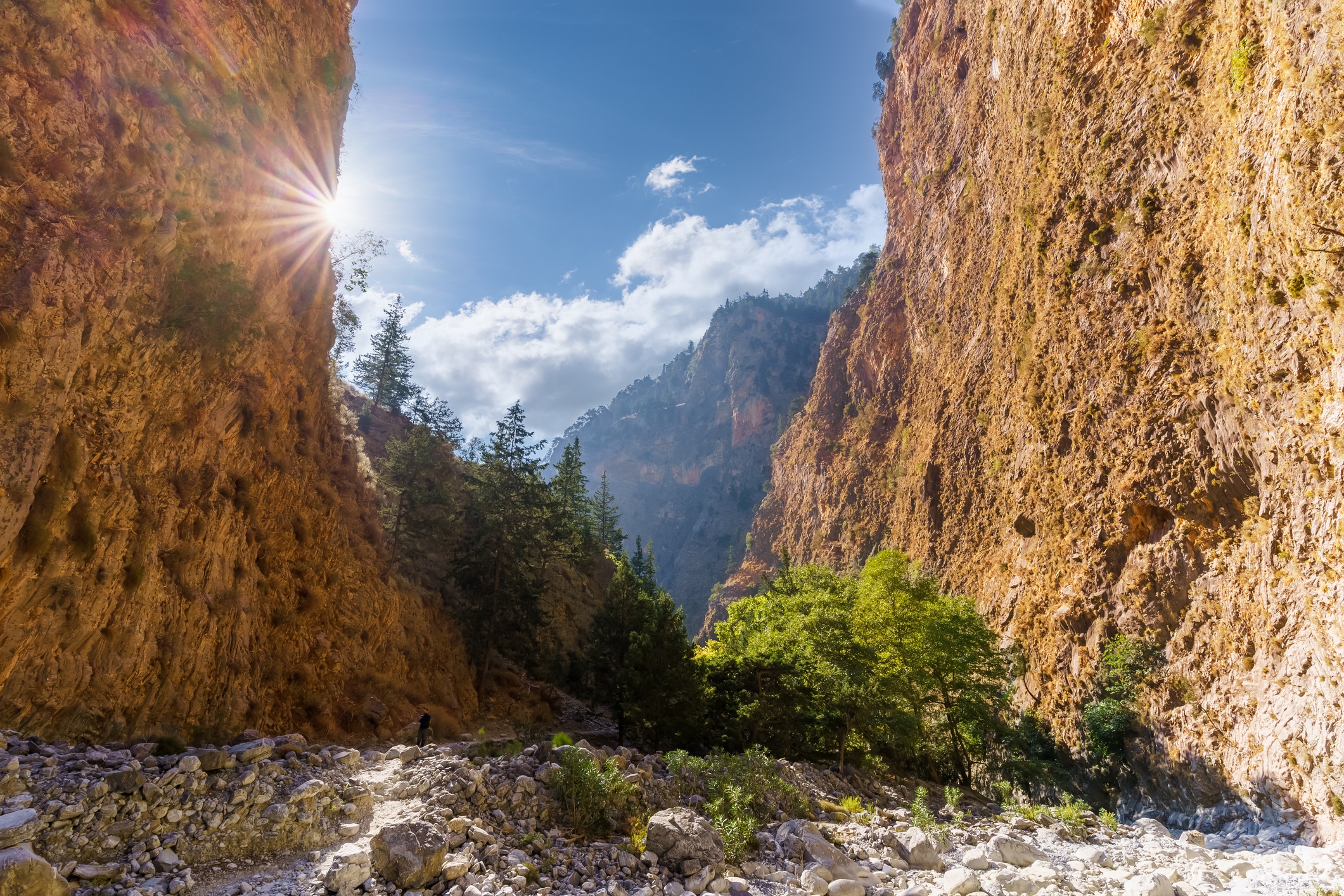Crete: the Kingdom of canyons
Crossed by numerous gorges, Crete has 57 peaks over 2,000 m and many climbing routes. Mountain dwellers, the Cretans remain very attached to their history and their values: family, mutual aid, pride and we must not touch their honor!
kingdom of canyons, Crete has more than 400 gorges, including those of Aradena (Chania, Sfakiá region in the south of the Lefká Óri massif). From Loutró, it is possible to cross the Aradena Gorge, which is dotted in June with oleanders in bloom (a 15 km loop), or to go up to the Anopoli Plateau (where you can stay in a typical inn) via Marmara beach and Livanianá*.

The Trek to Go Back in Time
Dried from April onwards, the Agia Irini Gorge start from Sougia and cross the western part of the White Mountains (a round trip route of 5,6-km). They lead to the city of Lissos (located at the site of the current Ai-Kyrkos), famous since antiquity for its thermal springs.
Impregnated by this site’s majesty, the hiker takes himself for an archaeologist and goes back in time to the Minoan (3100-1100 B.C.), Hellenistic (Doric temple of Asklipios of the 3rd century B.C. located at the southwestern terrace of the sanctuary: until the end of antiquity, the ancient Lissos was a renowned center of worship in Hellenistic times), Roman (necropolis of the 1st century with fifty vaulted tombs) and Byzantine societies (churches of the Virgin Mary and of Agios Kirikos of the 14th century) which have lived on these places.
Deserted by tourists this Saturday, June 19, 2021, the site and its various monuments open to the public are discovered with solemnity. We leave them with regret by throwing a last glance on the sublime bay of Lissos which saw so many lives and beliefs prospering there.

In the Samaria Gorge
Located in the park of the White Mountains which they cross, the famous Samaria Gorge (Farangas) are the most important in Europe, after those of the Verdon. Their width goes from 150 to 3 m, at the narrowest passage called the gates (pórtes). Its cliffs, where the most intrepid figs and cypress trees manage to cling, rise to 600 m. As it has snowed a lot this winter, the water is abundant on this day June 18th.
The ascent of the gorge – from the village of Agia Roumeli located at sea level to the Omalos Plateau (1,250 m) – makes it possible to avoid the majority of hikers who go through it in the opposite direction.
Shaped by time for thousands of years, this fusion of water, mineral and vegetation (more than 300 species of plants, including 70 endemic and 30 threatened with extinction) is also a landmark of history. Opposed to the Venetian, Ottoman and Nazi (from 1941 to 1944) occupations, the Cretan resistance fighters have found refuge over the centuries.
Perpetuation of the Memory
Originally from the White Mountains, the traditional monophonic songs, rizitika (from the Greek riza meaning root) in Cretan dialect, perpetuate their memory. Frequently, as it happened at the To Exari inn in Omalos in the evening of Saturday, June 19, small groups of men gather to sing these songs in chorus.
Also very present in the local culture are the folk dances – more than thirty, still practiced today especially during weddings, celebrating the heroism, the courage and the rebellious character of the Cretans. “Dance? Did you say dance?”
Mountain Dwellers
The island has 57 peaks over 2,000 m and many climbing routes [French article], including in the southern part of Heraklion Prefecture the Gorge of the Saints (Agiofarago) and Mount Kofinas (1,231 m), peak of the Asterousia Mountains, the southernmost in Europe. In the Chania Prefecture, the gorge of Therisso offers various climbing trails.
“The Cretans remain very attached to their history and their values: family, mutual aid, pride and we must not touch their honor! They are mountain dwellers, including in their mentality,” says Efi Petinaki, a guide from La Balaguère, a French travel agency specializing in trekking: “Very warm, they are known in Greece for their hospitality and their hot-headed temperament. It is better not to rush them: siga, siga (gently, gently)! ”
A rebellious state of mind forged by a tumultuous history that summarizes well the maxim of Níkos Kazantzákis:
I hope for nothing. I am not afraid of anything. I am free.
Lorem ipsum dolor sit amet, consectetur adipiscing elit. Ut elit tellus, luctus nec ullamcorper mattis, pulvinar dapibus leo.
* Using a portion of the European route E4, a 3.5 km coastal path leads from Loutro to Marmara Beach, then to Livaniana (1.4 km) and the plateau of Anapoli (4.8 km).
How useful was this post?
Click on a star to rate it!
Average rating 5 / 5. Vote count: 8
No votes so far! Be the first to rate this post.



Une réponse